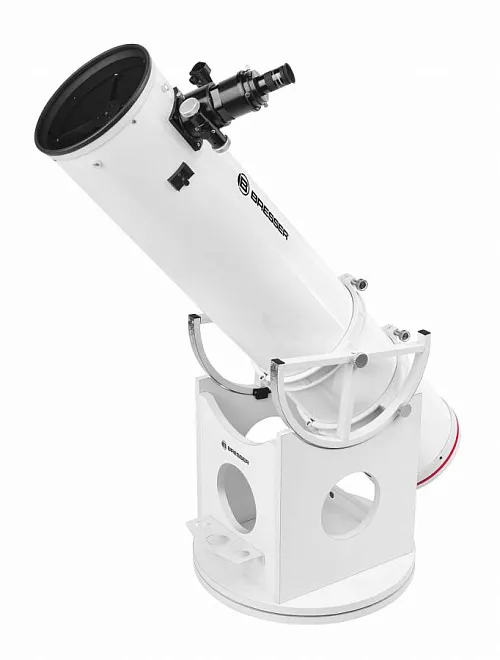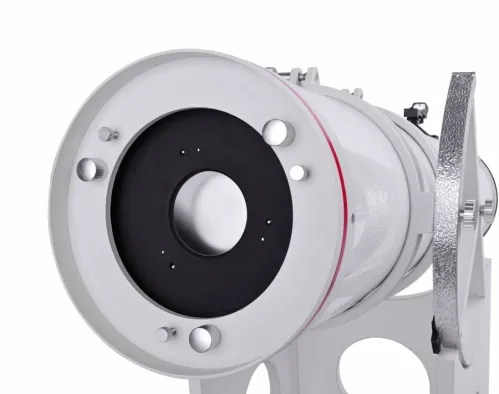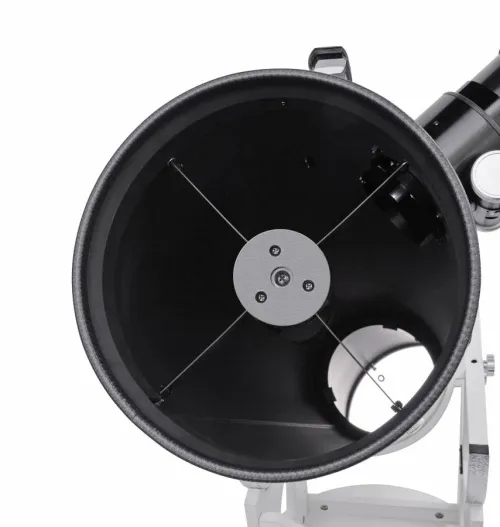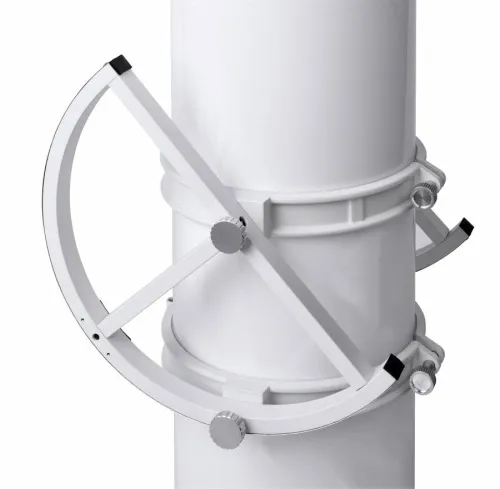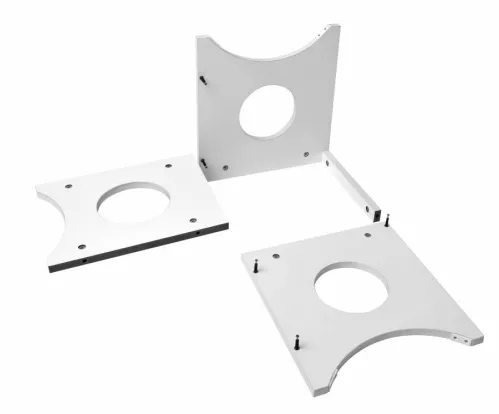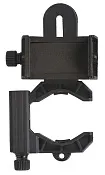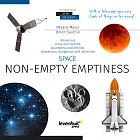Bresser Messier 8" Dobsonian Telescope
Newton's telescope. Primary mirror diameter (aperture): 203mm. Focal length: 1218mm
| Product ID | 72874 |
| Brand | Bresser GmbH, Germany |
| Warranty | 2 years |
| EAN | 4007922028415 |
| Package size (LxWxH) | 39x126x55 cm |
| Shipping Weight | 29 kg |
Bresser Messier Dobsonian Telescope is a real breakthrough. This powerful Newtonian telescope gathers a lot of light due to its large 203 mm (8") optical tube diameter. You can explore numerous celestial objects, including the Moon and the planets as well as the deep-sky objects. The telescope features parabolic primary mirror made of H-PZ33 low expansion glass. Forget about vignetting due to its Hexafoc focuser with a 65 mm (2.5") diameter. Large widefield eyepieces are supported by the big altitude wheels that easily carry heavy eyepieces. You only need to move the tube in its tube rings and balance the telescope within seconds. Moreover, these large wheels provide smooth and precise movement even at high magnifications.
This telescope system is versatile: if you need to use this telescope for astrophotography, you can remove the altitude wheels from the tube rings, attach a dovetail, and it is ready to go. Moreover, the focuser handles even heavy cameras tilt and shifting-free. Assemble and disassemble this telescope easily and quickly: the parts of the rocker box are connected with the standard metal furniture fasteners. That is practical for compact storage or transportation of the telescope.
Features:
- Primary mirror diameter: 203 mm
- Focal length: 1218 mm
- 2.5" HEXAFOC focus
- Primary mirror made of special-purpose glass with little thermal expansion
- Shifting-free focusing, even with heavy accessories
- Easy to move the tube
- Dismountable rocker box
- Optics can be attached to other mounts
- Differently sized adjusting- and lock-screws
The kit includes:
- Newtonian reflector
- LED viewfinder
- 25 mm Super Plössl eyepiece (Ø 31.7 mm/1.25")
- 1 extension shell 37.5 mm for 2.5" Hexafoc
- 1 eyepiece adapter Ø 31.7 to 50.8 mm
- 2 tube clamps
- 2 altitude wheels
- 1 rockerbox with 2 ground boards and assembly material
| Product ID | 72874 |
| Brand | Bresser GmbH, Germany |
| Warranty | 2 years |
| EAN | 4007922028415 |
| Package size (LxWxH) | 39x126x55 cm |
| Shipping Weight | 29 kg |
| Optical design | reflector |
| Optical scheme | Newtonian |
| Primary mirror diameter (aperture), mm | 203 |
| Secondary mirror diameter, mm | 57 |
| Focal length, mm | 1218 |
| Highest practical power, x | 400 |
| Aperture ratio | f/6 |
| Resolution threshold, arcseconds | 0.6 |
| Finderscope | red dot |
| Mount | Dobsonian |
| Optical tube weight, kg | 11.5 |
and downloads
Convenient diagrams that describe how to install additional accessories on refractors and catadioptric telescopes
Find out how to assemble a telescope on an example of the Levenhuk Skyline 90x900 EQ telescope
This short guide will help you avoid typical mistakes and learn more about telescope and mounting types
The basics of astronomical observations for beginners
In this article we have gathered answers to some of the most frequently asked questions about telescopes
How telescopes work?
You can actually perform observations from your balcony!
All about telescope sizes, types, magnification, and mounts
Learn how to set up and use the telescope properly
Astronomy in light-polluted skies. Find out what you can observe in the city
Read an interesting comprehensive article on telescopes for little astronomers
Celestial objects you can observe with telescopes of different apertures
Colored and vivid images of galaxies, planets and star clusters entrance everyone who is fascinated by boundless space
Find an interesting review on the history of the changes to a refracting telescope
To make the process of choosing a telescope easier, we will tell you about the characteristics of the most popular types of telescopes today
Learn everything you need to know about refractor telescopes to make the right choice

